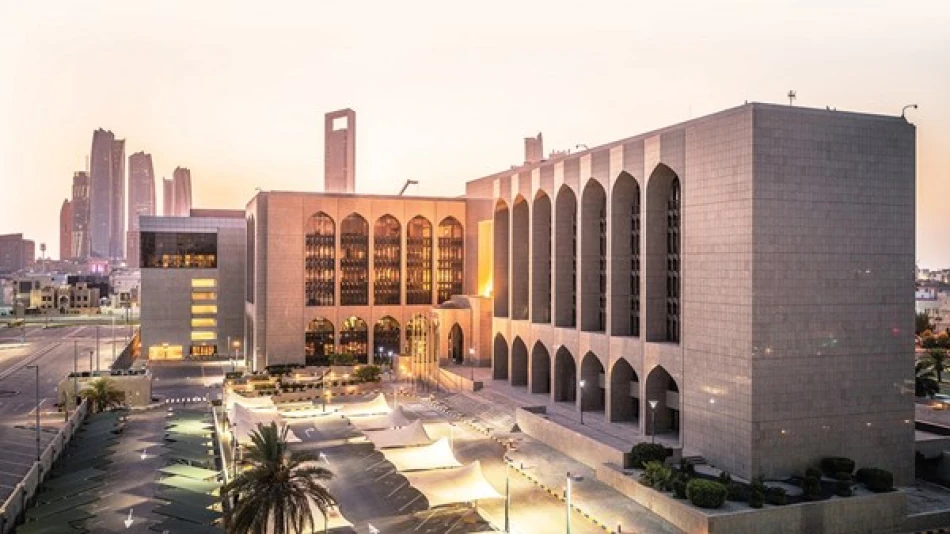
Central Bank's Gold Reserves Surge 25.9% to AED 28.9 Billion
UAE Central Bank's Gold Holdings Surge 26% as Banking Sector Shows Robust Growth
The UAE Central Bank has significantly bolstered its gold reserves by 25.9% in the first five months of 2025, reaching AED 28.9 billion—a clear signal of the nation's strategy to diversify away from dollar-dependent assets amid global economic uncertainty. This gold accumulation coincides with impressive banking sector expansion, with Abu Dhabi banks alone growing assets by 15.2% year-on-year to AED 2.3 trillion, underscoring the UAE's emergence as a regional financial powerhouse.
Strategic Gold Accumulation Reflects Global Trend
The UAE Central Bank's gold reserves jumped by AED 5.95 billion from December 2024 to May 2025, reaching AED 28.933 billion. This 25.9% increase mirrors a broader global trend among central banks seeking to reduce dependence on traditional reserve currencies.
The timing is particularly significant as central banks worldwide have been net buyers of gold for over a decade, with 2024 marking another record year for official sector purchases. The UAE's aggressive accumulation strategy aligns with similar moves by China, Russia, and India, all seeking to hedge against geopolitical risks and currency volatility.
Monthly Growth Momentum Continues
Even on a month-to-month basis, the UAE's gold holdings grew by 0.49% in May 2025, adding AED 142 million. This consistent accumulation suggests a deliberate, systematic approach rather than opportunistic buying, indicating long-term strategic planning by UAE monetary authorities.
Abu Dhabi Banks Drive National Growth
Abu Dhabi's banking sector has emerged as a growth engine, with total assets reaching AED 2.306 trillion in May 2025—a remarkable 15.2% year-on-year increase. This growth trajectory reflects the emirate's successful economic diversification and its position as a regional business hub.
Credit Expansion Signals Economic Confidence
Total credit extended by Abu Dhabi banks reached AED 1.078 trillion, representing an 11.5% annual increase. More importantly, private sector credit grew 7.4% annually, reaching AED 629.3 billion—a strong indicator of business confidence and economic activity.
This credit expansion is particularly noteworthy given global tightening monetary conditions. While many economies face credit constraints, the UAE's banking sector continues expanding lending, suggesting robust domestic demand and sound risk management practices.
Islamic Banking Outpaces Conventional Growth
The most striking trend within the UAE's banking landscape is the superior performance of Islamic banks, which are experiencing faster growth across all key metrics compared to conventional banks.
Islamic Banks Show Superior Asset Growth
Islamic banks recorded 17.4% annual asset growth compared to 13% for conventional banks. Their total assets reached AED 869.1 billion in May 2025, while conventional banks held AED 4.009 trillion. Despite the size difference, Islamic banks are gaining market share through superior growth rates.
Credit and Investment Performance
Islamic bank credit surged 19.5% annually to AED 530.4 billion, significantly outpacing conventional banks' 7.9% growth. Similarly, Islamic bank investments grew 14% annually versus conventional banks' 17.9%—though conventional banks still lead in absolute investment volumes at AED 617.2 billion.
This performance differential suggests growing market acceptance of Islamic banking products and potentially superior risk-adjusted returns in Sharia-compliant financing structures.
Investment Surge Indicates Capital Deployment Strategy
Abu Dhabi banks' total investments jumped 23.2% annually to AED 421.2 billion, the fastest growth rate among all banking metrics. This aggressive investment stance likely reflects several factors:
Excess liquidity deployment: With deposit growth at 12.3% annually, banks are actively seeking yield-generating opportunities beyond traditional lending.
Government infrastructure projects: The UAE's massive infrastructure spending, including preparations for COP28 legacy projects and Vision 2071 initiatives, likely absorbs significant banking sector investments.
Regional expansion: UAE banks are increasingly investing in regional markets, leveraging their strong capital positions for geographic diversification.
Market Implications and Future Outlook
The UAE's banking sector strength, combined with strategic gold accumulation, positions the country favorably for several emerging trends:
For investors: UAE bank stocks may benefit from continued margin expansion and asset quality improvements, though rapid growth requires monitoring of risk management practices.
For regional competition: The UAE's banking sector growth may pressure neighboring financial centers like Qatar and Kuwait to accelerate their own financial sector reforms.
For monetary policy: Strong credit growth may eventually prompt the Central Bank to consider moderating expansion to prevent overheating, though current indicators suggest sustainable growth levels.
The combination of prudent reserve management through gold accumulation and robust domestic banking sector expansion reflects a maturing economy successfully balancing growth with financial stability—a model that other oil-dependent economies are likely studying closely.
Most Viewed News

 Layla Al Mansoori
Layla Al Mansoori






